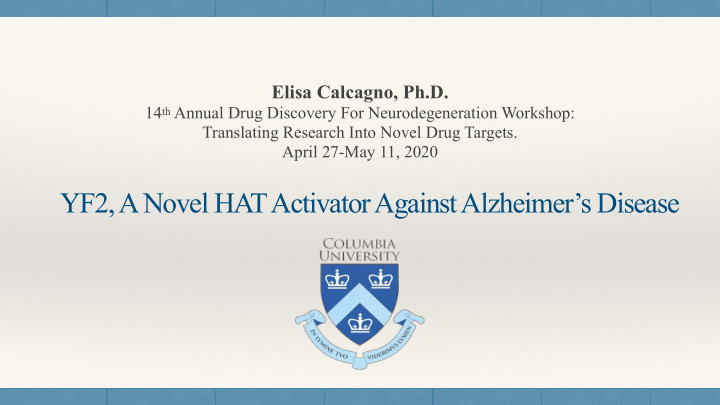



Elisa Calcagno, Ph.D. 14 th Annual Drug Discovery For Neurodegeneration Workshop: Translating Research Into Novel Drug Targets. April 27-May 11, 2020 YF2, A Novel HAT Activator Against Alzheimer’s Disease
Background - Memory is modulated by epigenetics through regulation of gene expression - The competing activities of histone acetyltransferases (HATs) and histone deacetylases (HDACs) influence the post-translational acetylation status of chromatin, which regulates gene Acetylation expression. - Histones acetylation causes the chromatin structure to open making the DNA more accessible to transcription factors. This promotes the transcription of genes involved in memory process.
YF2 has good pharmacodynamics and pharmacokinetics properties and is not toxic A B C D Acetylation syte EC 50 (nM) 72.54 nM ± 0.27 H3K27 155.01 nM ± 0.32 H3K18
YF2 rescues A β -induced defects in synaptic plasticity and memory A B C APP/PS1 mice D E F A β -infused mice
YF2 rescues Tau-induced defects in synaptic plasticity and memory A B C
Future Directions/Conclusions MEMORY LTP HAT acetylation represents a very ▪ promising strategy to ameliorate Activators synaptic function and memory for the treatment of AD and AD-related disorders. We have designed and synthesized a ▪ library of 74 small molecules of which 2 compounds have shown improved Acetylation metabolic stability. Acknowledgments Donald W. Landry, Ottavio Arancio, Jennifer Amengual, Shi-Xian Deng, Jole Fiorito, Elisa Zuccarello, Yuxuan Liu, Luuk De Vries, Agnieszka Staniszewski, Hong Zhang, Erica Acquarone
Recommend
More recommend